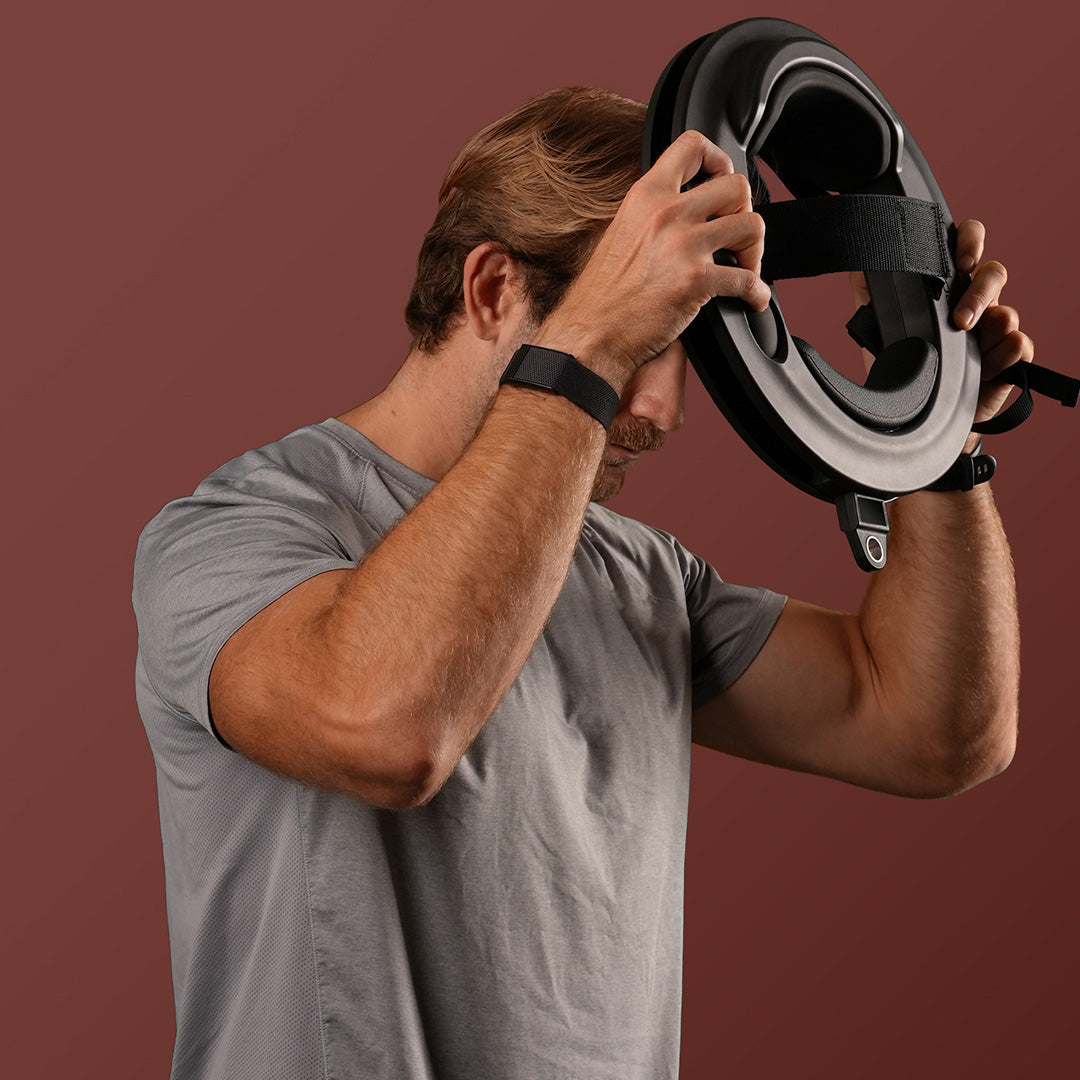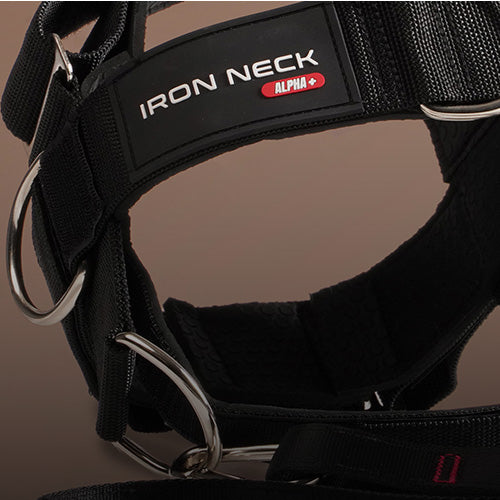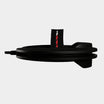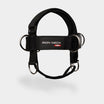When you picture a neck injury, you probably imagine catastrophic spine damage, bone breakage, and tons of downtime recovery. But it's not always that extreme, and damage can result from common everyday activities: Sports, driving, even something as simple as bad posture. The neck is an incredibly easy part of your body to injure.
Knowing what type of neck injury you are prone to, and having a proper exercise program, can greatly improve your recovery time. Not only that, but strengthening the neck can help you maintain a strong spine, good posture, and prevent chronic pain from developing in the future. Today, we'll cover the different types of neck injuries and explain which exercises you can rely on to help you prevent them in the first place, or recover faster and build up a stronger neck in the process.
Common Types of Neck Injury
When it comes to neck pain or injury, there are quite a few likely culprits. Here are some of the most common.
Ligament strains
Ligaments are the fibrous connective tissue that connects the bones and holds the structures of our bodies together. When the ligaments of the neck are overworked, this can damage them and cause injury. Seemingly benign activities can often lead to ligament damage. A strenuous exercise regiment, an overly ambitious stretch, and participation in sports have all been known to damage the ligaments of the neck. The force of these activities can easily hurt the soft tissues of the neck and spine.
Whiplash
Often associated with car crashes, whiplash can occur due to any quick and violent motion involving the head and neck. This movement can stretch the muscles and nerves beyond their elastic limits, causing the neck to react by tightening. More serious cases of whiplash can lead to spinal injury, but even a minor occurrence will strongly tighten the neck muscles. These tight muscles can cause pain in the head and neck, numbness, and a feeling of weakness in the extremities. These symptoms can make exercise very difficult, eventually leading to an atrophy of the muscles.
Repetitive strain
Repetitive strains can vary, but the most common one we experience is at our desks. If you work at a computer, and consistently find yourself crouched over your keyboard, your muscles are experiencing a repetitive strain. This strain on the cervical spine results in stiffness and aches that can annoy you throughout your workday. It's easy to think of poor posture as a benign bad habit, but over time this strain has a compounding effect. If you continue long enough and don't exercise the muscles properly, it can lead to a condition known as tech neck.
Tech neck
Tech neck, named for its connection to the usage of modern technology, is a malformed posture that can negatively affect the cervical spine and surrounding muscles. Instead of keeping good posture with the shoulders and head backward, your neck begins to slowly slide over a period of months or years. This slippage can eventually lead to a hunched appearance and significant pain.
How should i deal with these injuries?
While the root causes of these common types of neck damage may vary, the solution is quite simple: exercise. Any competent physical therapist will tell their patients that proper stretching and exercise are the best tools you can use to attain a healthy body. As long as you are careful, and take it slow, a good regiment of neck stretches and exercises will aid in your recovery process.
How can exercise help with neck pain?
Exercise is the foundation for most physical therapy programs, and professional medical advice dictates that as long as you move with caution, a good stretch can loosen up tight ligaments and relieve persistent neck aches. Neck pain can be difficult to deal with, and starting these programs may feel like an uphill battle. After neck damage, your symptoms may include increased pain and decreased range of motion. This neck pain and reduced mobility can destroy your motivation to take charge of your recovery, causing you to sit and wait for your neck to fix itself.
a physical therapist will recommend strengthening the neck ASAP
A doctor will often recommend their patients start exercising as soon as possible to ensure rapid recovery.
Make sure to have your physician provide medical advice on the best time to start, as they'll have the latest news on your neck's condition. But once they say you are ready, get started immediately. Once you begin, it's important to keep the regiment going even after you have recovered, to prevent pain from returning in the future. Even if you feel better after a few days, your physician will most likely recommend you continue completing the exercises on a regular basis.
what are the other benefits of having strong neck muscles?
Besides speeding your recovery from a neck injury, and preventing future pain, exercising the neck is the basis for a strong and healthy body. A powerful neck will allow you to properly perform many other types of exercise, including workouts that target your spine, chest, arms, and shoulders.
improve cardiovascular exercise
Cardiovascular fitness exercises like distance running can be affected by poor neck strength, as improper posture can lead to injury. Running, if done correctly, can significantly help with weight loss. If done incorrectly, it can damage your joints, especially in your knees.
Improve Posture
The cervical spine, located in the neck, is one of the key components to maintaining good posture. If you don't strengthen your spine, it can weaken as you age, causing your posture to degrade. This will gently pull your chin forward as well, leading to the hunched forward spine and weak joints we often associate with the elderly.
the most effective and safe exercises for a neck injury
These neck stretches and simple exercises can help you recover from injury, while simultaneously strengthening the neck and spine. Make sure your doctor approves each exercise beforehand, and proceed slowly during every stretch.
chin tucks
A chin tuck is a fundamental exercise designed to deal with any type of neck pain. Your starting position will be standing with your head facing straight ahead. You'll also want your arms by your sides, and your shoulder blades pulled back. First, slowly pull your head back, tucking your chin towards your neck. Hold this position for 10 seconds, and stop if you feel any increased pain. Once you release, push your chin back out, slowly returning to a neutral position. Continue this pattern of release, 10 seconds, repeat, for as many chin tucks as you feel comfortable completing. If you need help guiding your neck, you can use your left hand to gently push your chin backward.
rotation of the neck muscles
A neck rotation can release the build-up of lactic acid due to injury and is an incredibly simple exercise to complete. Just like the chin tuck, you'll start from a neutral starting position, making sure to hold the position while you steady your arms and legs. Begin with your head parallel with your shoulders. Then, gently rotate your head from that starting position to your right shoulder, making sure you watch for any sign of pain. Hold that position for 5 seconds, then slowly rotate your head back to the left shoulder. Once again, hold for five seconds. Follow this sequence for several sets: right shoulder, 5 seconds, left shoulder, 5 seconds, repeat.
side bending
If you want to work the right and left side flexions of the neck, side bending is a comfortable stretch that does so. As with each stretch or exercise, begin with the shoulder blades back and the head facing straight ahead. From this starting position, very carefully move your ear towards your right shoulder, and hold the position for 5 seconds. Then, after returning the head back to center, and take the left ear over to the left shoulder. Hold this for five seconds as well, or until you begin to feel the slightest pain. Continue this sequence of motions, right ear, 5 seconds, left ear, 5 seconds, repeat, until you feel as though you are done stretching the flexions of your neck.
spine extension
If you want to exercise the forward flexion and extension movement patterns of the neck, spine extensions are a comfortable stretch to do so. Begin by standing straight with your shoulders back. Then, push the head backward and face it towards the sky. Hold that position for several seconds, then shift your head forward to the chest until you feel a stretch in the back of your neck.
Follow this sequence for each set: head back, hold the position for several seconds, head to chest, hold the position for several seconds, repeat. As with every one of these exercises, it's important to stop if you feel any pain whatsoever.
do these exercises work with bodyweight?
While the exercises listed above can function with the weight of your head and body alone, it isn't the best solution for a hurt neck. You will most likely have to complete each exercise many more times than you would without the use of proper equipment, as there is very little force for the muscles to resist during the workout. While less weight may seem safer, being forced to exercise more frequently may actually increase the risk of further pain. Using only the weight of your head to stretch the neck means repetition, and increases the odds of accidentally using improper form. It's best to use resistance training equipment to ensure you remain focused on quality over quantity.
why is resistance training better than bodyweight training?
Resistance training works better because it optimizes each exercise you do, strengthening the neck and relieving tension and pain far more rapidly than using bodyweight alone. As long as you approach the exercises with care and caution, they can help stretch the ligaments and reduce the stiffness hampering your mobility. Strengthening the neck has been proven to remedy neck pain and improve the overall quality of life. With resistance training, you can get this improved quality with less effort. Once you've decided to use resistance training, you'll need to choose the company with the best neck resistance training equipment.
Where can I get the best resistance training equipment?
If you want to speed your recovery from neck injury safely, you'll want to go with Iron Neck. Used by doctors and physical therapists, it's proven to reduce pain, and ensure you feel stronger and healthier than ever before. Our flagship product, the Iron Neck, is the #1 neck strengthener available on the market. This miraculous device features multi-directional resistance, allowing for 360 degrees of unparalleled training capability. If the Iron Neck models are outside of your price range, our line of premium bands and neck harnesses can also help with your neck rehabilitation. Don't wait for your neck to slowly heal on its own. Choose the equipment that physical therapists all over the country are using to help their patients recover more quickly. Recover at the pace you want with Iron Neck.











